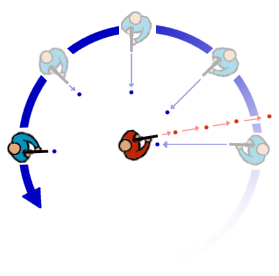Circlestrafing
|
|
In video games, particularly in first-person shooters (FPSs), circlestrafing is the technique of moving around a target in a circle while facing it. Circlestrafing allows a player to fire continuously at an opponent while dodging counterattacks. By rapidly circling the opponent, the player evades the opponent's sights. Circlestrafing is most useful in close-quarters combat, where the apparent motion of the attacking player is greatest, and thus the chance is highest that his opponent will become disoriented and lose track of him. The effectiveness of the circlestrafing maneuver is mitigated when the opponent's weapon fires projectiles that travel instantaneously, or fires a large number in a machine gun-like fashion.
Manual circlestrafing is achieved by walking sideways while turning smoothly. On PC games such as Quake, the popular control combination of using the mouse to control angle and the keyboard to move the character makes circlestrafing fairly simple to perform, although the inevitable (and often panicked) "pedaling" action of the mouseŚraising it at the end of the mousepad and setting it down on the other sideŚcan give the circling avatar a jerky, febrile path. Players reduce the need to "pedal" by turning up the in-game mouse sensitivity, but increased sensitivity may compromise their targeting ability. Alternately, they can use trackball pointing devices, and for this reason trackballs are many gamers' preferred pointing devices.
Some games feature a system to handle the turning automatically, which means that the player only has to move sideways to travel along the perimeter. A prominent example is the "Z-targeting" system of Legend of Zelda: Ocarina of Time, which locks the character's viewpoint onto an enemy when the Z button is pressed.
Many players of first-person-shooters circlestrafe continually for most close-quarters battles, often combining this with unpredictable changes of direction and transverse dodging. Two skilled players fighting in this manner will frequently attempt to circlestrafe around one another, their movements describing intricate and complex patterns like spirals and figures-of-eight. Circlestrafing is an effective means of lessening the advantage held when one player has a more powerful weapon than the other, and by closing to melee range and circling, an attacker with an otherwise puny weapon can defeat an opponent whose powerful explosive weapon (such as a rocket launcher) cannot safely be used at such close quarters.
Some players also combine circlestrafing (and similar rotary dodging motions) with dodge-jumping, in the hope of avoiding splash damage from rockets fired at the ground at their feet, while simultaneously affording them a better (i.e. steeper) angle at which to fire such ground-directed shots of their own (with the rocket being fired at the apex of the jump's trajectory). There is also some additional dodging value due to the jumper's added vertical motion. In older FPS games which allow air control (where the simplistic in-game physics allows a player to change direction mid-flight) this enhances the unpredictability of the player's position. In later FPS games, which largely remove air control, this maneuver is, if not entirely ineffective, at least much less effective, and thus more rarely seen.
When the attacked player merely stands still and tries to turn to track his attacker, he will be defeated: the circlestrafer presents a moving target, the victim a static one. In such cases, circlestrafing is a highly effective technique. Countermeasures do, however, exist:
- The defending player himself circlestrafes, generally in the contrary direction to his attacker. Done properly, this ensures the attacker cannot duck "behind" the attacked, and makes the attacked player as difficult to hit as his attacker.
- When combined with a backward motion, the defensive counter-circlestrafe described above results in the two players spiraling apart. This often happens when players have weapons that require them to keep some distance between each other and their respective targets before they can be safely or effectively used.
- In games that permit it, a rocketjump allows one player to leap high above the field of combat, avoiding his circlestrafing nemesis and pelting him with gunfire from above.
- Keeping close to an obstruction, such as a pillar or, ideally, a wall, allows a player to prevent his opponent from flanking him. Mutual-circlestrafe conflicts often end when the action spirals into a confined space such as a corridor or doorway in which the required free movement is blocked.
- A target with an indirect (or area-denial) weapon can use it to confuse his opponent or disturb the delicate pattern of his circlestrafe. Bouncing weapons such as grenades, or delayed-action weapons like time-bombs, can have this effect, allowing the target the opportunity to flee and regroup.
Many bots are programmed to employ circlestrafing, and extremely rapid and fluid circlestrafing is a tell-tale sign that a player is in fact either a bot or an aimbot-assisted human.

